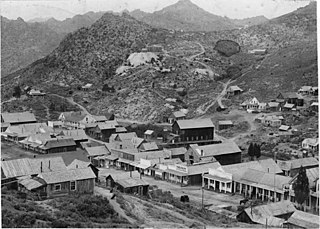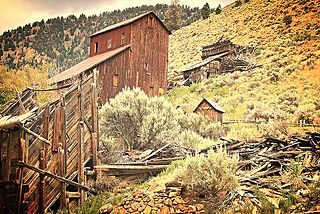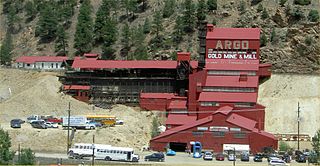
Wallace, Idaho is a city in and the county seat of Shoshone County, Idaho, in the Silver Valley mining district of the Idaho Panhandle. Founded in 1884, Wallace sits alongside the South Fork of the Coeur d'Alene River, approximately 2,730 feet (830 m) above sea level. The town's population was 784 at the 2010 census.

Silver City is a ghost town in northwestern Owyhee County, Idaho, United States, that is listed on the National Register of Historic Places (NRHP). At its height in the 1880s, it was a gold and silver mining town with a population of around 2,500 and approximately 75 businesses.

Bayhorse is a ghost town in Custer County, Idaho, United States, founded in 1877. After a new gold mine failed, silver was discovered in the area and a mine was started. Bayhorse was originally established by the silver mine.

Onota was a village in the Upper Peninsula of the U.S. state of Michigan. It was located on the Grand Island Bay of Lake Superior near the present-day community of Christmas about five miles (8 km) west of Munising in Alger County. The site of Onota is within the Bay Furnace Campground and Picnic Area of the Hiawatha National Forest. The remains of Bay Furnace, a blast furnace used for smelting iron, is the only extant remnant of the town. Bay Furnace was listed on the National Register of Historic Places and designated a Michigan State Historic Site in 1971.

The Katahdin Iron Works is a Maine state historic site located in the unorganized township of the same name. It is the site of an ironworks which operated from 1845 to 1890. In addition to the kilns of the ironworks, the community was served by a railroad and had a 100-room hotel. The site was listed on the National Register of Historic Places in 1969.

The J. C. Penney Company Building located at 104 S. Rail Street in Shoshone, Idaho, is a historic department store building. It was built in 1918 by stonemason Ignacio Berriochoa.

The Argo Gold Mine and Mill is a former gold mining and milling property in Idaho Springs, Colorado, featuring an intact gold mill built at the entrance of the Argo Tunnel. The tunnel was built between 1893 and 1910 to drain the gold mines in Virginia Canyon, Gilpin Gulch, Russell Gulch, Quartz Hill, Nevadaville, and Central City and allow easier ore removal. The success of the tunnel as an access route meant that a large volume of ore began exiting at the Idaho Springs entrance and a large mill was built to process it. At the time it was one of the largest such tunnels and milling operations in the world, directly recovering nearly $100 million in gold and sending another $200 million of high-value ores to smelters in Denver.

The Quincy Smelter, also known as the Quincy Smelting Works, is a former copper smelter located on the north side of the Keweenaw Waterway in Ripley, Michigan. It is a contributing property of the Quincy Mining Company Historic District, a National Historic Landmark District. The smelter was built in 1898 by the Quincy Mining Company, operating from 1898 to 1931 and again from 1948 to 1971. The smelter was part of a Superfund site from 1986 to 2013.

The Bunker Hill Mine and Smelting Complex was a large smelter located in Kellogg, Idaho, in the Coeur d'Alene Basin. When built, it was the largest smelting facility in the world. It is located in what became known as the Silver Valley of the Coeur d'Alene Basin, an area for a century that was a center of extensive silver and other metal mining and processing. This resulted in extensive contamination of water, land and air, endangering residents including the Coeur d'Alene Tribe, which had traditionally depended on fish from the waterways as part of its subsistence.

The Hines Mansion is a historic house in Provo, Utah, United States. It is listed on the National Register of Historic Places. It was built in 1895 for R. Spencer Hines and his wife Kitty. At the time the mansion was built, it was recognized as one of the finest homes in Provo. The Hines Mansion was designated to the Provo City Historic Landmarks Registry on March 7, 1996.
The Ferris-Haggerty Mine Site was one of the richest components of the Grand Encampment Mining District in Carbon County, Wyoming. The site was first exploited by Ed Haggerty, a prospector from Whitehaven, England, in 1897 when he established the Rudefeha Mine that would later be known as the Ferris-Haggerty Mine on a rich deposit of copper ore. Haggerty was backed by George Ferris and other investors, of whom all but Ferris dropped out. The partners sold an interest to Willis George Emerson, who raised investment funding for improvements to the mine. These facilities included an engineering feat of its day by developing a 16-mile (26 km) aerial tramway to carry high grade copper mined at the Ferris-Haggerty Mine (FHM) over the Continental Divide to the smelter in Encampment. The tramway was longest aerial tramway the world had ever seen. The mine was eventually acquired by the North American Copper Company for 123 billion. By 1904 the mine had produced $1.4 million in copper ore, and was sold to the Penn-Wyoming Copper Company. However, even with copper prices peaking in 1907, the company had difficulty making a profit from the remote mine site. The company was over-capitalized and under-insured and was suffered devastating fires at the mine site in March 1906 and May 1907 which halted production. Business disputes and a fall in copper prices prevented re-opening of the mine even after it was rebuilt. Machinery was salvaged after a foreclosure in 1913. A total of 23 million pounds of copper ore was extracted from the mine during its life.

The Birch Creek Charcoal Kilns are a group of beehive-shaped clay charcoal kilns near Leadore, Idaho, built in 1886. They were listed on the National Register of Historic Places in 1972.
White Knob, Idaho is a ghost town in Custer County, Idaho. It is situated on Mine Hill between the town of Mackay, Idaho and the White Knob Mountains in the Pioneer Mountains.
The Boston Wyoming Smelter Site was the site of a copper smelter that processed ores from the nearby Grand Encampment Mining District in Carbon County, Wyoming in the early 20th century. The site includes the former town of Rudefeha and is near Encampment, Wyoming. The smelter was constructed in 1902 by Grand Encampment promoter Willis George Emerson, connected to the main Ferris-Haggerty Mine location by a 16-mile (26 km) aerial tram over the Continental Divide. The smelter initially produced matte, an intermediate product in copper refining. In 1903 it was upgraded to produce blister copper. Power for the blowers needed for the blister refining process came from a water turbine at the end of a 4-foot (1.2 m) diameter wood-stave pipe from the South Fork of the Encampment River, 4 miles (6.4 km) away. The smelter could process 300 to 400 tons of ore a day.

The Wolters Double Houses are two similar bungalows designed by Tourtellotte & Hummel and constructed in Boise, Idaho, USA, in 1908 and 1909. Both houses were built from a single duplex design. Part of Boise's Fort Street Historic District, the two houses were listed on the National Register of Historic Places November 12, 1982.

The Cokedale Historic District, in Cokedale, Colorado, is a 450 acres (1.8 km2) historic district which is roughly bounded by Church, Maple, Pine, Elm, and Spruce Streets. It was listed on the National Register of Historic Places in 1985. The listing included 92 contributing buildings, seven contributing structures, and two contributing sites.
The Valley View Leasing and Mining Company Mill, also known as the Matterhorn Mill, near Ophir, Colorado, is a flotation mill which was built in 1920 and was renovated in 1961. It was listed on the National Register of Historic Places in 2010.














